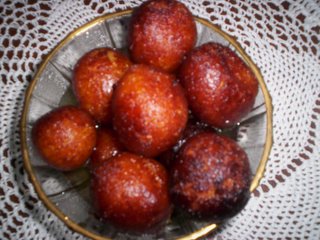Real SWEET sweet smile...
Diwali, the sparkling Indian festival of candles and fireworks, just went by. It's followed by another festival called bhai-duj. It's known as bhai-phota in Bengal and is marked by sisters putting a mark on their brothers' forehead, with wishes for their safety and well being. Since childhood, I have looked forward to this day for the delightful stuff my mother makes that day.The enormously tempting fare almost always comprises luchi (check out this space for that one)along with chholar dal and begun bhaja or fried eggplants. And that is followed by some mouthwatering traditional sweets my mother makes so painstakingly.
 Pantua is one such. Almost the same as the famous Indian dessert gulab jamun, the only difference with making pantua is the use of cottage cheese or paneer/chhena in it. Making gulab jamuns isn't tough anymore, what with the grocery stores flooded with premade mixes. But if you want the traditional taste, soft and blissful, try out this recipe.
Pantua is one such. Almost the same as the famous Indian dessert gulab jamun, the only difference with making pantua is the use of cottage cheese or paneer/chhena in it. Making gulab jamuns isn't tough anymore, what with the grocery stores flooded with premade mixes. But if you want the traditional taste, soft and blissful, try out this recipe. Pantua: Steps with Ingredients:
1. Make paneer/chhena made from 1 litre skimmed milk: To do this, bring the milk to a boil and squeeze in the juice of one whole lemon in it. The milk would solidfy and float on the top of the vessel. Cool it and pour into a cotton cloth pouch. Hang the pouch to drain the water out of the paneer.
2. 150 gms of homemade khoya: For this, my mother adds some sugar (use discretion) and raisins into the milk and boils it on slow flame, until the milk turns into a sticky solid state. Keep stirring so it doesn't get burnt.
3. Mash the paneer, with the water drained out, into a paste-like consistency. Ma does this with her hands and it takes a fair amount of patience...Okay, now add the khoya to this and mash some more.
4. Divide this mixture into 8 equal parts. Take flour equalling one of these parts, add a teaspoon of baking powder and a teaspoon of ghee in it. Now bring all the 8 parts together and add the flour mixture into it. Make a dough.
5. Make small balls of the dough. Take each ball, make a well in its centre with your finger. Put a seed of black cardamom and one grain of misri or sugar crystal in the well and remake the ball by rolling it in your palms.
6. Sugar syrup: Take about 500 gms of sugar and four cups of water in it. Bring to a boil, but make sure the syrup isn't too thick.
7. Deep fry the balls in oil or ghee.
8. Pick them up and dip into the sugar syrup. Let the balls soak in the syrup and...
9. SERVE!
Another sweet Ma makes is a typical Bengali dessert called lobongo-lotika. This is basically a pastry made of flour, filled with khoya or condensed, dry milk and raisins, and sealed with a lobongo or clove stick. I don't have a sweet tooth, but this is one dessert I really savour. So here's sharing it with you all :)

Lobongo-lotika: Steps and Ingredients:
1. Make khoya in the same way as for pantua (see step 2 of Pantua above). You could add some shredded coconut to it for taste.
2. Take about 250 gms flour, add some water, a couple of tablespoonfuls of ghee and knead a dough, of a consistency neither too hard or soft. Divide the dough into about 8 portions.
3. Roll the portions into small puris. Put a tablespoon of the khoya mixed with raisins in the middle of the puri. Now fold it into a rectangle and seal with a clove stick in the centre. You can put even 2 sticks so it holds better.
4. Deep fry the rectangles.
5. Take 250 gms of sugar, add a cup of water in it and bring to a boil to make a thick syrup.
6. Now dip the fried lobogo lotikas or rectangles in the sugar syrup.
7. Serve cold.
Note: You can add some rose water into the sugar syrup for both the above desserts.
Try these and share with others. I am sure some hearty smiles will fly back in your general direction.
Sury


5 comment(s):
well well...well said ! and eat well.
By Anonymous, at
1:57 PM
Anonymous, at
1:57 PM
looks simple delish. great site you have here.
By Anonymous, at
1:26 AM
Anonymous, at
1:26 AM
Thanks for stopping by, Rokh. You have a very pretty blog too. The pics there had me drooling. :P
Keep checking in :)
By Anonymous, at
10:54 AM
Anonymous, at
10:54 AM
oh gosh, at LAST I have a name for that gorgeous sweet - lobongo lotika... they're scrummy. I've had a variation of those at a Lebanese sweet shop in Paris - how I wish it was available where I live!
By Anonymous, at
5:15 PM
Anonymous, at
5:15 PM
You are right Shammi. Lobong-lotikas are delightful. The Lebanese sweet you referred to...I wonder if you are talking about Baklawa. Indeed divine too, albeit made very differently than our humble clove dessert. :P. Here's a link for the Lebanese pastry: http://www.syrialive.net/food/baklava.htm
By Anonymous, at
9:42 AM
Anonymous, at
9:42 AM
Post a comment
<< Home